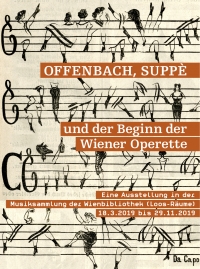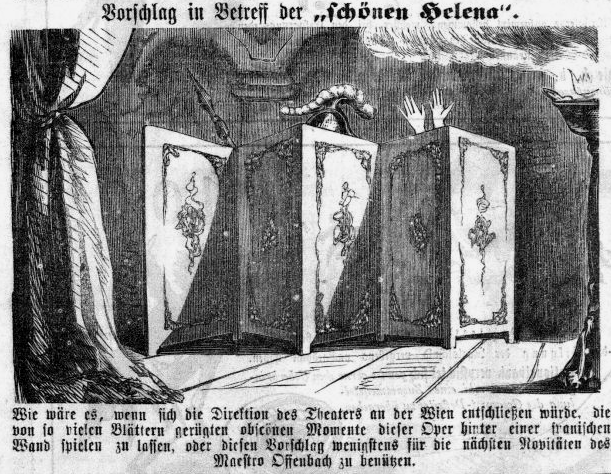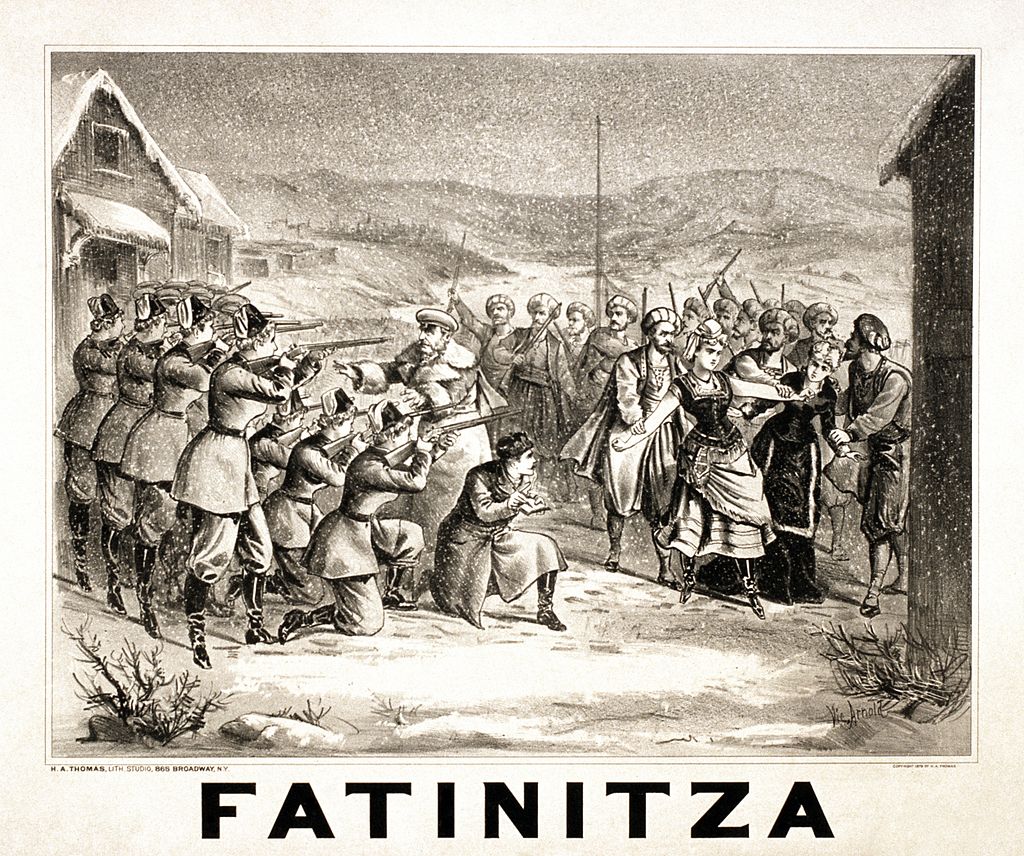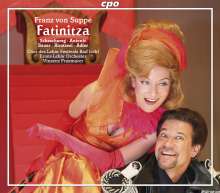Michael Hardern
Operetta Research Center
27 February, 2019
For 2019, the Wiener Institut für Strauss-Forschung (WISF) is offering a three-day operetta ‘special‘ that‘s entitled Zur Geburt der Wiener Operette: Musikalische und historische Wurzeln. Heute – Reminiszenz oder Aktualität? This translates as: ‘About the Birth of Viennese Operetta. Musical and Historic Roots. Today – Nostalgia or Topical?’ The three-day event includes a “Wiener Strauss-Kolloquium“ with prominent guest speakers such as Marion Linhardt, a performance by students of the Musik und Kunst Privatuniversität der Stadt Wien (MUK), and a symposium dedicated explicitly to early productions of operetta and their reception in Vienna: Offenbach, Suppé, and Strauss. And: a new exhibition with some glorious objects from the Viennese archives!

“Die neuesten Noten des Herrn Jacques Offenbach,” i.e. the latest compositions from Mr. Jacques Offenbach. From: Kikeriki, 1865.
The kick-off is on Thursday, 14 March, in the grand hall (‘Festsaal’) of the Österreichische Akademie der Wissenschaften, which is the Austrian Academy of Sciences. There, Eduard Strauss will present a 1895 article entitled “Wien und Strauss – zwei Begriffe, die sich völlig decken,” by Ferdinand Brezowsky.
This is followed by Marion Linhardt and a talk on “Johann Strauss’ frühe Operetten und die Wiener Sehnsucht nach dem Eigenen.” Since Miss Linhardt has published widely and profoundly critical on this ‘nationalist’ and often ‘anti-semitic’ tendency of the Viennese trying to create something ‘of their own’ in answer to the ‘decadent’ French ‘invasion’ of Offenbach, it shall be interesting to hear what she has to say 13 years after Residenzstadt und Metropole first came out, a book that brilliantly mapped the terrain in 2006.

Franz von Suppé, in 1885.
After Miss Linhardt, Thomas Aigner presents statements that honor the 200th birthdays of Jacques Offenbach (20 Juni 1819) and Franz von Suppè (18 April 1819). Then, Norbert Rubey discusses What Remains? – About the Reception of Operettas by Offenbach, Suppé, and Strauss (“Was blieb übrig? – Zur Rezeption der Operetten von Offenbach, Suppè und Strauss”).
The evening is framed with overtures by these three composers, performed by Ingomar Rainer and Collegium musicum der mdw – Universität für Musik und darstellende Kunst Wien.
Next day, 15 March, the MUK students present Die Geburt der Wiener Operette: Musikalische und historische Wurzeln at the Vivaldi-Saal (ÖJAB-Haus) in Johannesgasse, at 10 am. Their professor, Wolfgang Dosch, explores the Austria-Viennese ‘Singspiel’ and ‘Zaubermärchen’ as origins for ‘Wiener Operette.’ The program will pay special hommage to Franz von Suppé.
That same afternoon, at 3 pm, a symposium starts at the Institut für Musikwissenschaft der Universität Wien, in the great lecture hall (‘Großer Hörsaal’) in Garnisongasse 13.
Thomas Aigner asks Was ist Oper? Was ist Operette? – which should definitely lead to an interesting discussion. Especially interesting for English speaking visitors is Peter Kemp from Marlow Bottom, England. He’ll talk about: What is Operetta? The Sources of Operetta and the National Variations of the Form that Arose. (Kurt Gänzl recently discussed the same topic here on the Operetta Research Center site.)
Wolfgang Dosch discusses Vom Alt-Wiener Singspiel zur Wiener Operette. Vom ‚komponierenden Kaiser‘ bis zum ‚Walzerkönig‘ Musikalisches Unterhaltungstheater in Wien seit 1680, i.e. he’ll trace the roots of operetta back to the late 17th century, which is what Franz Hadamowsky and Heinz Otto also did in 1947 with their book Die Wiener Operette. Ihre Theater- und Wirkungsgeschichte.
That book, by the way, first introduced the terms “Silver” and “Golden” operetta.

Franz Hadamowsky and Heinz Otto, “Die Wiener Operette. Ihre Theater- und Wirkungsgeschichte,” 1947.
My friend Kevin Clarke from the Operetta Research Center is up next with Derb bis zum äußersten und bis zum Exzeß gesteigert. He asks why operetta historians do not include the academically researched, edited and easily available historic source material on the original reception of operetta in Vienna in the 1860s and 70s. Is it prudery? Do they think the scandalized reactions back then (and the equally ‘scandalous’ sexual quotes from Strauss himself) are not befitting for a cultural heritage phenomenon like ‘Viennese Operetta’ and a genius like Strauss? (The latter was suggested, back in 2003, in the exhibition/catalogue Johann Strauss ent-arisiert. It presented the pornographic drawings by Strauss in a very public way and included them in a general discussion of his personality and music making.)

The 1878 drawing by Johann Strauss showing an opulently proportioned lady. He sent this card entitled “Auf der Seehundjagd in Wyk auf Föhr” to his lawyer Dr. Max Neuda; it shows Mrs. Neuda and contains a highly suggestive poem.
The first day of the 2019 Tanz-Signale symposium finishes with Ingomar Rainer and Zwischen Bearbeitung und Recycling. Zur Verbreitung der Operette (“Between Adaptation and Recycling. About the Spreading of Operetta”).
Directly afterwards, a brand new exhibition opens at 7 pm in the music collection of the Wienbibliothek, which is where Johann Strauss ent-arisiert was once shown. The promising sounding title of the new exhibition is Offenbach, Suppè und der Beginn der Wiener Operette. It’s curated by Thomas Aigner. (We pray there will be a catalogue, even a small one like Johann Strauss ent-arisiert! And we wonder, just a tiny bit, why Hans-Dieter Roser as Suppé’s latest biographer wasn’t invited as a speaker for any of these Suppé events, considering that he actually lives in Vienna. Maybe it’s another one of many modern Viennese operetta mysteries.)

The exhibition “Offenbach, Suppè und der Beginn der Wiener Operette,” curated by Thomas Aigner, 2019.
The poster shows ‘the latest compositions from Mr. Jaques Offenbach’ (“Die neuesten Noten des Herrn Jaques [sic] Offenbach”). It’s a caricature from the satire magazine Kikeriki, 1865. That same edition of Kikeriki contains two other highly telling caricatures about Offenbach and La Belle Hélène which adress the many criticized ‘obscene moments’ in that work. The magazine suggests ‘to hide these moments behind a folding screen’ (Spanische Wand) at Theater an der Wien. What you see is, essentially, the bedroom scene between Helena and Prince Paris in which the Spartan queen takes off her clothing before going to bed, only the bed then surprised by the nightly visitor who joins her in bed – as a dream gone astray.

A caricature on “Die schöne Helena” in Vienna, in “Kikeriki,” 1865.
Kikeriki also points out that ‘today actresses do not only appear on stage in such a way’ as they do in Schöne Helena. No, even worse, ‘they cannot wait to get photographed in such outfits,’ which is apparently documented by postcards on sale in downtown Vienna (“Am Graben”). It’s a great early form of merchandize. And it leaves few questions as to what made operetta so successful, originally!

An advertisement, of sorts, for “Schöne Helena” postcards in Vienna, from “Kikeriki,” 1865.
On Saturday, 15 March, the symposium is mostly dedicated to Johann Strauss. There is Norbert Linke talking about Jettys Bemühungen um Inthronisation des Operetten-Komponisten Johann Strauss bis zum ‚geheimen Fünferbund‘, i.e. Jetty Strauss‘ attempt to put her husband on the throne of operetta king.
Other speakers include Isabella Sommer (Johann Strauss – Experimente auf dem Weg zur Operetten-Komposition) and Martina Kalser-Gruber (“Vendiamo la musica di copiosa, quando i cuori ancora sono caldi!” – Das Geschäft der Musikverlage mit der Operette).

Composer Carl Millöcker.
Norbert Rubey moves onto Carl Millöcker (Seine ersten Jahre als Theaterkapellmeister in Graz, Wien und Pesth).
Johannes Leopold Mayer addresses the odd combination of ‘frivolity’ and a ‘kyrie fugue’ in the oeuvre of Suppé (Franz von Suppè – Frivolität und Kyriefuge).

Poster for Franz von Suppé’s “Fatinitza.”
Michael Lakner, theatre director in Baden bei Wien, discusses Suppé’s cross-dressing hit Fatinitza (“Fatinitza: Travestie im Kriegsgewirr”). He was responsible for the staging at the Ischl festival, of which there is a CD. (Which is not exactly a wet Suppé dream; but that’s a different story.)

The 2007 recording of Franz von Suppé’s “Fatinitza” from Isch. (cpo)
In the afternoon, there’s a concert (“Musikalische Enquete”) entitled „… nach Motiven von … – ein Recycling der Operette,“ a performance by Collegium musicum der mdw, directed by Ingomar Rainer.

Johann Strauss in Ischl, 1897. (Photo: Die Villen von Bad Ischl/Amalthea)
If you are still around on Sunday, 17 March, you can join a gathering at Müller‘s Heuriger at 11 am with Schrammel music, finishing the festivities on a rustic note and with “Verschrammelter Strauss.”
For more information and exact times of all the talks, click here. The events are free entry.
